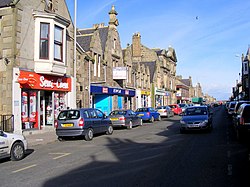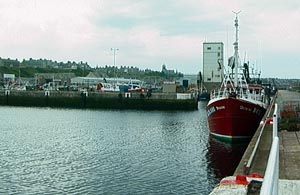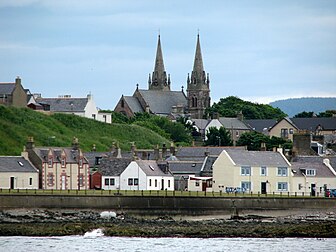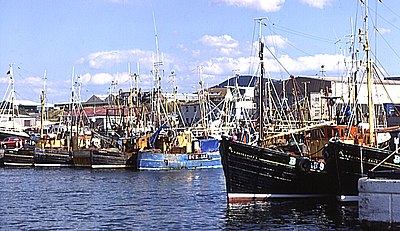Buckie: Difference between revisions
No edit summary |
|||
| Line 15: | Line 15: | ||
| dialling code= 01542 | | dialling code= 01542 | ||
}} | }} | ||
'''Buckie''' the largest town in [[Banffshire]]. It stands on the [[Moray Firth]], 17 miles from each of [[Banff]] to the east and [[Elgin]] to the west. [[Keith, Banffshire|Keith]] lies 15 miles to the south by road though far less as the crow flies. | '''Buckie''' is the largest town in [[Banffshire]]. It stands on the [[Moray Firth]], 17 miles from each of [[Banff]] to the east and [[Elgin]] to the west. [[Keith, Banffshire|Keith]] lies 15 miles to the south by road though far less as the crow flies. | ||
The town is, broadly speaking, laid out in a [[linear]] fashion, following the coastline. There is a lower shore area and an upper area. Fundamentally Buckie itself is the central part of the community lying between the Victoria Bridge under which flows the Buckie Burn at the western end of West Church Street, the eastern end of Cluny Harbour and above the shore area. To the west of Victoria Bridge and lying above the shoreline is Buckpool and on the shoreline, west of Cluny Harbour, between Baron Street and the Buckie Burn mouth, there is The Yardie. To the east of Cluny Harbour lie Ianstown, Gordonsburgh and [[Portessie]] also known locally as ''The Sloch'' (historically ''The Rotten Slough'') which reaches towards [[Strathlene]]. These communities were, to all intents and purposes, separate fishing communities which gradually merged. A new town was laid out above the shoreline in the 19th century and this is the rump of Buckie. | The town is, broadly speaking, laid out in a [[linear]] fashion, following the coastline. There is a lower shore area and an upper area. Fundamentally Buckie itself is the central part of the community lying between the Victoria Bridge under which flows the Buckie Burn at the western end of West Church Street, the eastern end of Cluny Harbour and above the shore area. To the west of Victoria Bridge and lying above the shoreline is Buckpool and on the shoreline, west of Cluny Harbour, between Baron Street and the Buckie Burn mouth, there is The Yardie. To the east of Cluny Harbour lie Ianstown, Gordonsburgh and [[Portessie]] also known locally as ''The Sloch'' (historically ''The Rotten Slough'') which reaches towards [[Strathlene]]. These communities were, to all intents and purposes, separate fishing communities which gradually merged. A new town was laid out above the shoreline in the 19th century and this is the rump of Buckie. | ||
Latest revision as of 15:04, 6 January 2015
| Buckie Gaelic: Bucaidh | |
| Banffshire | |
|---|---|
 East Church Street looking eastwards | |
| Location | |
| Location: | 57°40’32"N, 2°58’57"W |
| Data | |
| Population: | 8,059 (2001) |
| Post town: | Buckie |
| Postcode: | AB56 |
| Dialling code: | 01542 |
| Local Government | |
| Council: | Moray |
| Parliamentary constituency: |
Moray |
Buckie is the largest town in Banffshire. It stands on the Moray Firth, 17 miles from each of Banff to the east and Elgin to the west. Keith lies 15 miles to the south by road though far less as the crow flies.
The town is, broadly speaking, laid out in a linear fashion, following the coastline. There is a lower shore area and an upper area. Fundamentally Buckie itself is the central part of the community lying between the Victoria Bridge under which flows the Buckie Burn at the western end of West Church Street, the eastern end of Cluny Harbour and above the shore area. To the west of Victoria Bridge and lying above the shoreline is Buckpool and on the shoreline, west of Cluny Harbour, between Baron Street and the Buckie Burn mouth, there is The Yardie. To the east of Cluny Harbour lie Ianstown, Gordonsburgh and Portessie also known locally as The Sloch (historically The Rotten Slough) which reaches towards Strathlene. These communities were, to all intents and purposes, separate fishing communities which gradually merged. A new town was laid out above the shoreline in the 19th century and this is the rump of Buckie.
Buckie as a port
Cluny Harbour is probably still the true heart of Buckie and this project was built by the Cluny family in 1877 to replace the town's first stone harbour in Nether Buckie which was constructed in 1857 a mere mile or so to the west but had a tendency to silt up and become unusable. [1] The Laird of Letterfourie had contributed £5,000 of the construction costs at Nether Buckie but the main investor with the balance of £10,000 was the Board of Fisheries. The engineers were D.&T. Stevenson of Edinburgh, the family firm of the author Robert Louis Stevenson. It was and remains a very sturdily built edifice with the main walls of considerable thickness being built of quartzite, quarried locally at Strathlene, capped with a very hard type of sandstone which was also used to form the walls at the entrance and of the harbour proper. As regards stability the harbour has remained a monument to engineering science with very little maintenance ever being necessary. It had a design fault, however, in that the entrance opened to the north east and was subject to infill with shingle, moving westwards by longshore drift. Later known as Buckpool Harbour this earlier port became something of an eyesore and eventually the silted basin became overgrown and dangerously swampy. The decision was taken to fill in the basin and this work was undertaken in the 1970s. The resulting park includes a pebble beach and the original quartzite harbour walls remain completely intact.
The name

The origin of the name of the town has caused some debate and although the popularly accepted version is that Buckie is named after a seashell (of the genus buccinum) the reality is that the shared marine background is merely a coincidence. The name Buckie would originally have occurred in identifying a place that was not immediately adjacent to the sea so we must seek alternative etymological sources. Unfortunately in one of the earlier books on Scottish place names Buckie on the Moray Firth does not receive a mention although Buckie, spelt the same way, in the Balquhidder district of Perthshire is described as being derived from the Gaelic word boc or Welsh bowk, both meaning a buck or male deer so this would suggest the meaning of Buckie as place where male deer gather and this specifically would most likely have been the valley of the Buckie Burn.
In an article by a Dr Crammond in 1936[2] he speaks of the earliest mention of Buckie being in 1362 when the lands of Rove Bucky in le Awne were leased by John Hay to John Young, vicar of Fordyce. The Hays, of whom the Rannes family have descended, had acquired through Royal favour a footing in the district at a still earlier age when the greater part from the Deveron to the Spey was embraced in the Forest of Awne or Ainie (now Enzie) and the Boyne. Rove Bucky is far from understandable and could be a scribe's error and should perhaps read Over Bucky as occurs in older title deeds, in contra distinction to Nether Buckie. It has been spelt in different ways, Robert Burns called it Bucky in his poem Lady Onlie - Lady Lucky. This was the form at the end of the 18th century.
Robert Gordon’s map Aberdeen, Banf, Murrey &c. to Inverness: [and] Fra the north water to Ross[3] which is dated at some time between 1636-1652 shows Buckie in its own right as a community some small distance from the coast with the community of Freuchny sitting nearer the shore to the north. Robert Gordon and Joan Blaeu’s Duo Vicecomitatus Aberdonia & Banfia, una cum Regionibus & terrarum tractibus sub iis comprehensis[4] published in Amsterdam 1654 clearly shows Buckie and Freuchny with the addition of Nether Buckie. James Robertson’s Topographical and military map of the counties of Aberdeen, Banff and Kincardine,[5] London, 1822 seems geographically inaccurate in its relative positioning of Buckie, Nether Buckie and Freuchny but is significant in that the new label of Rotten Slough is given equal importance in terms of size of community with Buckie; however in Thomson’s Atlas of Scotland,[6] Edinburgh, 1832 Rotten Slough is fairly unimportant by size so one of these two reference publications is distorted, probably the former. This community which would later come to be known as Portessie was reportedly formed when "Porteasie.....became a fishing station in 1727, when 5 houses were built by the proprietor of Rannes for the accommodation of the original fishers from Findhorn" and the 1731 Rathven Session Minutes shows that Rotten Slough already has a population of 40 with ten households and subsequent minutes show the community growing until the 1791 entry records 177 souls in 44 households.[7]
By the time of the publication of the 1891 First Series Ordnance Survey Map of Elgin[8] which reflects the 1866-1870 survey Buckie has developed markedly with areas named Seatown, Newtown, Ianstown and Portessie. The 19th century OS Six Inch series[9] further shows Gordonsburgh, Craig Bow and Strathlene. The 1910 OS 3rd Edition one-inch map of Elgin[10] has settled on the name of Ianstown and all other parts of Buckie are named as they are known today but then, just to confuse the issue, the Bartholomew Survey Atlas of Scotland,[11] Edinburgh, 1912 uses the label Ianston. The conflicting nomenclature continued with the issue of the 1929 OS One-inch Popular edition[12] and the 1933 JG Bartholomew & Son, Half-inch to the Mile maps of Scotland[13].
Churches

As a traditional fishing community Buckie has always had an active religious life the town’s churches are numerous, representing almost every branch of Northern European Christian faith. The largest church is the Roman Catholic church, St Peter's which stands on St Andrews Square in Buckpool, a twin-spired red sandstone construction was originally intended to act as the cathedral for the Roman Catholic Diocese of Aberdeen when it was opened in 1857.[14]
- Church of Scotland
- The North Church in Cluny Square. (This building houses the town clock and was opened in 1879.[15]
- Several other congregations
- Roman Catholic:
- St Peter's (above)
- St. Gregory's (Preshome) (the first Roman Catholic Church built in Scotland after the Reformation church to look like a church, not an anonymous clandestine church.[16]
- Methodist
- Salvation Army
- Scottish Episcopal Church
- Baptist
- Plymouth Brethren
- various congregational churches
Industry

Once a thriving fishing and shipbuilding port, these industries have declined. Indeed, although Peterhead and Aberdeen are more readily associated with the fishing industry in Northeast Scotland, by 1913 Buckie had the largest steam drifter fleet in Scotland.[17] Food processing remains important, with large fish factories and smoke houses found around the harbour. Buckie can properly be regarded as one of the main points of origin of the modern Scottish shellfish industry.[18] A Mancunian, Charles Eckersley, who moved to Buckie in the 1950s and started trading as a fish merchant noticed that many of the varieties of shellfish that were regarded as economically useless by Buckie fishing vessels (prawns, scallops etc.) were in fact the same species that he had enjoyed whilst completing his National Service in Palestine. He seized the opportunity to exploit this gap in the market and he built a thriving processing and packing business which eventually expanded to include factories as far afield as Barcelona and Alicante in Spain.
The Buckie Shipyard now repairs and refits RNLI lifeboats for much of the United Kingdom and operates service contracts for various other clients including the MoD as well as building new vessels but boatbuilding was a major industry in the town for decades. Until recent years there were three quite separate boatyards building traditional wooden clinker-built fishing vessels. Leaving Cluny Square and heading down North High Street, also locally known as the Bus Brae or Bowling Green Brae, the view of the sea would have been interrupted by a huge grey corrugated iron shed. This was Thompsons and vessels were launched directly into the sea from a slipway. Heading east to Cluny Harbour it would have been impossible to miss Herd and Mackenzie on the fourth or lifeboat basin of the harbour. Directly behind their large sheds and across Blantyre Terrace was Jones with their private harbour into which they launched their vessels. Thompsons is gone but the premises of Herd and McKenzie and Jones are part of the modern day Buckie Shipyard. It was Herd and McKenzie, a firm with its roots in Dunbartonshire from where Messrs Herd and Mackenzie sortied north, which built and launched the training schooner Captain Scott in 1972. At the time of its launch this vessel was the largest of its type in the world. In earlier years there were further boat construction operations dotted along the shoreline from The Yardie to Ianstown and on to Portessie but these had mostly been amalgamated into the three main firms or had gone out of business by the interwar period.
A significant part of the population works in the offshore oil industry although Buckie somewhat missed the boat with the North Sea boom. In the late 1970s there were extensive plans drawn up to extend Cluny Harbour out to the Mucks reef with the intention of serving oilfield supply vessels. Nothing came of this but every now and then the idea rears its head once more to be met with great enthusiasm before failing to get off the ground again.
Buckie was home to a specialist electric lamp factory of Thorn EMI until 1987[19] when it was closed and production moved to a new plant in Leicestershire. All of the predominantly female staff were offered jobs at the new facility in the East Midlands but, as the vast majority of the labour force were second wage earners in families, this offer was almost universally rejected.
Buckie is home to the Inchgower Distillery[20] which sits a mile or so inland from the town and is best known for the Inchgower Single Malt.[21]
Leisure
As is typical of towns in the area, Buckie is well served by golf courses with the eastern and western edges of the community ending in 18 holes. To the eastern extremity on a spectacular clifftop lies Strathlene Golf Course which stretches almost all the way to the village of Findochty and to the west, also on a clifftop, lies Buckpool Golf Club [1] which reaches a good part of the way to the village of Portgordon.
Adjacent to Buckie High School is Victoria Park, home of Buckie Thistle Football Club [2]. Although The Jags have been consistently high finishers in the Highland Football League in recent years the league title has eluded the club since it was last won in 1958. That was in a decade when all trophies available were won with regularity and it was during this era that Buckie Thistle travelled to Hampden Park to meet Queen's Park in a Scottish Cup 4th round replay on October 30, 1954, prevailing 2-1[22] and at the same time becoming the first and, still to this day, the only senior non-league club to have won a competitive match at the national stadium. The go-ahead board has extensively developed the stadium in recent years and a function hall was built within the perimeter of the ground so that sponsors and match-goers can now enjoy more sophisticated licenced and catering facilities pre- and post-match at the venue.[23]
In Buckpool, and next door to Buckpool Golf Club, is the Merson Park home of Buckie Rovers Football Club. The Rovers are members of the Scottish Junior Football Association and play in that body's North Region Division One. At one time they played at Victoria Park as well, alternating home fixtures with their senior cousins but when Buckie Thistle were suffering one episode of extreme financial duress the decision was taken to move to a new facility in the municipal Merson Park. As a club they have always played in the shadow of Buckie Thistle but they have a core of devotees who will always keep the Rovers going. The Merson Park ground is fairly rudimentary with only the perimeter fence and dugouts differentiating it from a municipal pitch and there are no covered or seated facilities at all.[24]
Near the southern edge of town on High Street lies Linzee Gordon Park. This is home to Buckie Cricket Club [3], which has a very long history with numerous Macallan North of Scotland Cricket Association League [4] titles in recent years (four in the past ten seasons to be precise) on top of various league and cup wins in the 1990s including two wins in the prestigious Scottish Cricket Union Small Clubs Cup, specifically in 1995 and 1997.[25] BCC built a modern pavilion to replace their aging home and this was opened in June 1998. The construction was partly funded by sportscotland and the National Lottery. Linzee Gordon Park, also has a municipal pavilion along with adjoining pitch for football use. Additionally, for some of the year, the football pitch at Linzee Gordon Park is converted to become a rugby pitch where Buckie RFC train and play home games.
Bowling is a popular pastime in Buckie and the town boasts two greens. Buckie Bowling Club is on North High Street and Low Street with attractive views over the Moray Firth from the clubhouse. Victoria Bowling Club sits on West Church Street adjacent to Victoria Bridge and the Buckie Burn flowing below.
Buckie has a 25m swimming pool which was built next to Buckie High School and opened in 1975.[5]
Buckie is at the end of the Speyside Way long distance footpath. There is magnificent coastal scenery all along the Banff coast, with easy access to areas such as Glenlivet, Speyside and the Cairngorms.
References
- ↑ "Buckie Feature Page on Undiscovered Scotland". Undiscovered Scotland. http://www.undiscoveredscotland.co.uk/buckie/buckie/index.html. Retrieved 2008-11-05.
- ↑ "Buckie Heritage : Buckie & District : Old Snippets". Buckie Heritage. http://www.buckieheritage.org/oldsnippets.htm. Retrieved 2008-11-21.
- ↑ "Counties of Scotland, 1580-1928 - Maps of Scotland:". National Library of Scotland. http://www.nls.uk/maps/counties/detail.cfm?id=9. Retrieved 2008-11-17.
- ↑ "Blaeu Atlas of Scotland, 1654 - Maps - National Library of Scotland:". National Library of Scotland. http://www.nls.uk/maps/atlas/blaeu/page.cfm?id=87. Retrieved 2008-11-17.
- ↑ "Topographical and military map of the counties of Aberdeen, Banff and Kincardine - Maps of Scotland:". National Library of Scotland. http://www.nls.uk/maps/joins/570.html. Retrieved 2008-11-17.
- ↑ "Northern Part of Aberdeen & Banff Shires - John Thomson's Atlas of Scotland, 1832:". National Library of Scotland. http://www.nls.uk/maps/atlas/thomson/523.html. Retrieved 2008-11-17.
- ↑ "Early Findochty & Portessie families". http://myweb.tiscali.co.uk/sheena_charles/FRSfams.htm. Retrieved 2008-11-17.
- ↑ "Ordnance Survey, One-inch to the mile maps of Scotland, 1st Edition - 1856-1891 - National Library of Scotland:". National Library of Scotland. http://www.nls.uk/maps/os/oneinch_1st_list.html. Retrieved 2008-11-17.
- ↑ "Ordnance Survey Maps Six-inch 1st edition, Scotland, 1843-1882 - National Library of Scotland:". National Library of Scotland. http://www.nls.uk/maps/os/6inch/index.html. Retrieved 2008-11-17.
- ↑ "Ordnance Survey, One-inch to the mile maps of Scotland, 3rd Edition - 1903-1912 - National Library of Scotland:". National Library of Scotland. http://www.nls.uk/maps/os/oneinch_3rd_list.html. Retrieved 2008-11-21.
- ↑ "Nairn, Elgin - Bartholomew Survey Atlas of Scotland, 1912:". National Library of Scotland. http://www.nls.uk/maps/atlas/bartholomew/page.cfm?id=1189. Retrieved 2008-11-21.
- ↑ "Maps: Viewing 74400588.sid:". National Library of Scotland. http://www.nls.uk:8080/StyleServer/calcrgn?cat=Maps&item=/74400588.sid&style=maps.xsl&wid=700&hei=500&browser=win_ie&plugin=false. Retrieved 2008-11-21.
- ↑ "Maps: Viewing 74467012.sid:". National Library of Scotland. http://www.nls.uk:8080/StyleServer/calcrgn?cat=Maps&item=/74467012.sid&style=maps.xsl&wid=700&hei=500&browser=win_ie&plugin=false. Retrieved 2008-11-21.
- ↑ "Buckie". The Scalan Association. http://www.scalan.co.uk/buckie.htm. Retrieved 2008-11-10.
- ↑ "Presbytery of Moray". Presbytery of Moray. http://www.moraypresbytery.org.uk/churches/display.php?id=33. Retrieved 2008-11-05.
- ↑ Kaplan, Benjamin J., Religious Conflict and the Practice of Toleration in Early Modern Europe, Harvard University Press, 2007, Chapter 8, pp. 198. ff..
- ↑ "Ports.org.uk/Buckie". Duncan Mackintosh. http://www.ports.org.uk/port.asp?id=649. Retrieved 2008-11-07.
- ↑ "Moray Seafoods". Moray Seafoods. http://www.morayseafoods.co.uk/. Retrieved 2008-11-07.
- ↑ "Authors turn spotlight on bulb factory - Press & Journal". Aberdeen Journals. http://www.pressandjournal.co.uk/Article.aspx/833972?UserKey=. Retrieved 2008-11-10.
- ↑ "Inchgower Distillery - The Distilleries of Scotland - scotchwhisky.net". www.scotchwhisky.net. http://www.scotchwhisky.net/distilleries/inchgower.htm. Retrieved 2008-11-07.
- ↑ "Inchgower Single Malt Scotch Whisky - scotchwhisky.net". www.scotchwhisky.net. http://www.scotchwhisky.net/malt/inchgower.htm. Retrieved 2008-11-07.
- ↑ "Scotland - Cup Results 1873/74-1877/78 and 1889/90-1995/96". Dinant Abbink/RSSSF. http://www.rsssf.com/tabless/scotcuphistfull.html#55. Retrieved 2008-11-10.
- ↑ "Victoria Park Function Hall". Buckie Thistle FC. http://www.buckiethistle.com/scottish-football/265/victoria-park-function-hall.html?PHPSESSID=lu90308om39dad7b1aomln4vv7. Retrieved 2008-11-24.
- ↑ "Soccerworld North First Division". nonleaguescotland.co.uk - Jamie Wire. http://www.nonleaguescotland.co.uk/region/north/northdiv1.htm. Retrieved 2008-11-24.
- ↑ "Small Clubs Cup 1997". Cricket Scotland. http://www.cricketeurope4.net/SCOTLAND/DATABASE/1997/DOMESTIC/SMALLCLUBSCUP/about.shtml. Retrieved 2008-11-10.